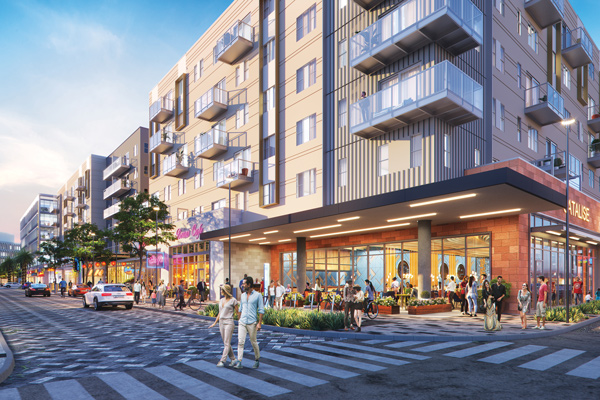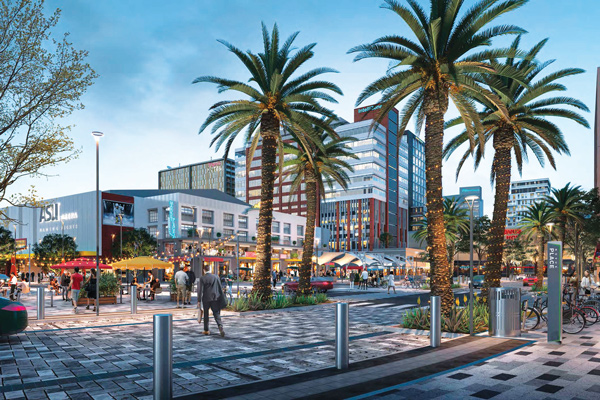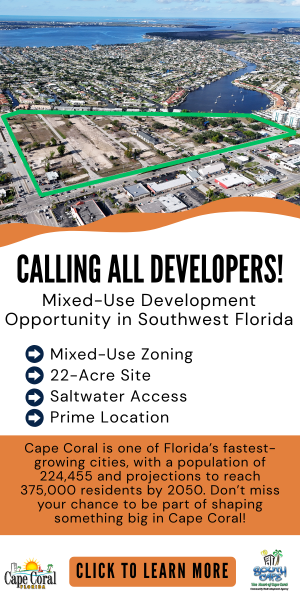Novus Innovation Corridor: A Model for Modern Cities

In Arizona, a new mixed-use development harnesses the power of universities to shape urban life.
Universities across the nation are facing a conundrum — how to maintain best-in-class sports facilities without using taxpayer or student dollars. Arizona State University (ASU) and Catellus Development Corporation may have found a solution.
The big idea: transform the last 355 acres on the university’s 100-year-old main campus in Tempe, Arizona, into a revenue-generating opportunity that benefits students and graduates, employers and the community at large. To that end, the Novus Innovation Corridor will encompass more than 10 million square feet of urban, mixed-use developments conceived and built with sustainability as a design condition and powered by smart infrastructure components to create a connected community.
The project has four pillars: To be an adaptive urban environment at the geographic crossroads of the Phoenix region; to become a global-caliber sports performance, training and entertainment destination; to make sustainability a design condition and be powered by smart city elements; and to be ASU-driven, with long-term alliances that create commerce opportunities and exceptional experiences.
Following a 20-year build-out across seven phases (two of which are already completed), Novus will feature 4.5 million square feet of Class A office space, more than 4,100 residences, 1,000-plus hotel rooms and 275,000 square feet of retail stores, restaurants and entertainment options in five pedestrian-friendly neighborhoods. There will be numerous outdoor spaces designed as gathering places for residents and visitors, as well as the 5,000-seat Mullett Arena, which will host ASU athletics and other sports and entertainment events. Additionally, Mullett Arena will serve as the temporary home of the National Hockey League’s Arizona Coyotes as the team works to develop and build a new permanent stadium in the area.
According to the U.S. Census Bureau, the Phoenix region added 160,000 residents between 2010 and 2020, making it the fastest-growing area in the country during that time. Naturally, a lot of development flows from that population growth. Amid this sea of activity, Novus will be within a 10-mile radius of 1.25 million residents and nearly 1 million employees, according to research by ASU and Catellus.
ASU President Michael Crow credits Novus for contributing to its designation as the most innovative university for the eighth year in a row in U.S. News & World Report’s annual Best Colleges rankings.
A Novel Concept
Novus was born out of a pioneering collaboration among three public- and private-sector partners — ASU, Catellus and the city of Tempe — to create a new type of development for modern cities while driving measurable economic results.
ASU came up with a plan to reimagine the university’s last developable parcels of land into something that would have a profound and lasting effect in creating a 21st-century university. As ASU’s development partner, Catellus is helping to bring this vision to life, drawing upon its more than 40 years of experience as a master developer in projects nationwide. The company has transformed former airports, military bases and urban industrial sites into retail, residential and commercial communities.

The Piedmont is a six-story, 318-unit luxury apartment community in the Novus Innovation Corridor. Courtesy of Novus Innovation Corridor
The city of Tempe also plays a central role in Novus, helping to guide the visioning process and choose a developer. At the start, Tempe saw the project’s potential to build upon the city’s investments and relationship with a top research university while leveraging the project’s proximity to the popular Tempe Town Lake and other local assets.
Realizing the financial pressures universities face and the public demand for top athletics facilities, ASU lobbied the state legislature twice to create a University Athletics Facilities District for the state’s three public universities. The idea was to lease Arizona Board of Regents’ land for private development while maintaining university ownership. This will allow the developers to pay fees to ASU instead of property taxes. Funds generated from the district would cover the cost to renovate existing sports facilities and finance new ones. The city of Tempe, along with the state and county, would receive revenues from the development. Tempe also would benefit from the project’s sales tax, as well as utility and infrastructure fees.
The statute passed in 2010, though not without controversy from some watchdog groups critical of the precedent that would be set by a public university becoming a private-sector real estate developer. ASU eased these concerns by citing the benefits Novus would bring to the community, such as tax revenue, jobs and increased economic development.
A Big Impact
Novus is one of seven ASU Innovation Zones, which are designed to provide access to knowledge, people and ideas while empowering businesses of all sizes — from startups to global enterprises — to grow and scale quickly. Through Novus, ASU aims to create high-wage jobs and new sales tax revenues while increasing surrounding property values and attracting new private investment to the area.
At Novus, entrepreneurs could be small companies with potential to grow, while larger national and global enterprises can benefit from the research capabilities and highly skilled workforce. The initiative leverages the knowledge assets of the university, including the brainpower of faculty, staff and students. This, in turn, will help attract companies looking to locate in an intellectual environment.
The opportunity to create this environment also has positive economic benefits.
ASU’s Seidman Research Institute projects that Novus will generate an economic impact of $1.86 billion and add 34,000 jobs by 2035 through office, hotel, multifamily and retail operations. The $1.86 billion impact includes the 2.1 million-square-foot Marina Heights office complex (Phase I) along Tempe Town Lake, the renovation of Sun Devil Stadium (Phase II), Hyatt Place/Hyatt House, 777 Tower, The Piedmont and Novus Place Parking Structure in Phase III, as well as ASU’s newest research and athletics facilities within Novus. The local economy will also benefit from more than 20,000 temporary construction jobs.
A Model for Sustainability
For developers locally, nationally and globally, green building is important. It helps combat climate change, foster sustainable and thriving communities, meet ESG goals and bolster economic growth.
Novus is an example of green building in action and represents ASU’s efforts in sustainability, which were recognized in April 2022 when the university was ranked second in the world and first in the U.S. in the Times Higher Education Impact Rankings, a measure of how well universities are meeting the United Nations’ Sustainable Development Goals. Novus will offer many opportunities for business collaboration and expansion via the integration of facilities and technologies.
A case in point: Novus became the first LEED-ND (Neighborhood Development) community certified at any level in Arizona. The Gold certification is the second-highest certification awarded by the U.S. Green Building Council on its scale of Certified, Silver, Gold and Platinum designations. The 62-point certification ranks Novus among the top 10 best-scoring LEED-ND projects ever in the U.S. The LEED-ND program is designed to combat urban sprawl by helping to create more sustainable and well-connected communities.

The 5,000-seat Mullett Arena will host Arizona State athletics and other sports and entertainment events. Additionally, it will serve as the temporary home of the National Hockey League’s Arizona Coyotes. Courtesy of Novus Innovation Corridor
Additionally, buildings within Novus are earning green building certifications, beginning with 777 Tower, a six-story building with 160,907 square feet of office space and 8,316 square feet of retail space, which achieved LEED Gold-level certification. In 2020, NAIOP Arizona named 777 Tower its Sustainable Project of the Year.
Novus will also focus on devising and implementing effective solutions in transportation, resource and utility usage, and responsible waste management. Companies co-locating at Novus will be at the center of an urban environment that’s connected to students, faculty and some of the nation’s top research facilities.
A Big Vision Beginning to Unfold
Aside from the economic impact, Novus will drive a significant influx of employment in cutting-edge industries while bringing education, commercial real estate, living, entertainment and research together in one location to develop the 21st-century university.
For example:
- Piedmont, a six-story, 318-unit luxury apartment community and another 500 units in two new multifamily developments.
- ASU Athletics will give local residents a state-of-the-art venue for sports competitions and other events with the multi-purpose Mullett Arena, which debuted at the Arizona Coyotes home opener in October. The arena also will host collegiate hockey, wrestling and women’s gymnastics, along with public concerts, youth competitions and other events.
- Hyatt Place/Hyatt House, Novus’ first dual-branded hotel with 259 rooms, a rooftop pool and bar with uninterrupted views and a host of other amenities, served approximately 130,000 guests from April 2021 to April 2022.
- ASU dedicated its newest research building — the Rob & Melani Walton Center for Planetary Health — last spring. The 281,000-square-foot high-performance research facility features a 389-seat presentation hall, public outreach and exhibit space, research labs and classrooms. The building houses ASU’s College of Global Futures, the Julie Ann Wrigley Global Institute of Sustainability, the Rob and Melani Walton Sustainability Solutions Service, the School of Sustainability, the Institute of Human Origins and the Starbucks Center for the Future of the People and the Planet.
A Promise for the Future
The world — especially the world of development — has evolved. Old modes of building are being replaced with creative new developments that will appeal to many different audiences in many different ways.
At Novus, entrepreneurial startups to global enterprises in emerging industries should be able to find a home.
The community’s highly walkable location, access to the light rail and proximity to all that ASU has to offer will be a magnet for Tempe’s skilled workforce, too. And the array of dining, plus daylife and nightlife, that is planned for the community’s Main Street retail district, Novus Place, will make it a destination for residents and visitors alike.
Best of all, the growth, jobs and commerce associated with Novus will enable one of the nation’s largest and growing universities (enrollment was more than 79,000 in August 2022) to operate from a more economically viable position and create a sustainable financial model for the future.
With all this in mind, an August 2022 report from Axios Phoenix noted that ASU and Catellus are fielding inquiries from universities, including Purdue, Ohio State and the University of California, Berkeley, about how they can replicate the Novus model.
Charley Freericks is senior vice president of Catellus Development Corporation.
Novus Innovation Corridor Fast Facts
- 355 acres
- 10 million square feet of mixed-use space
- Approximately 4.5 million square feet of Class A office space
- 4,100 planned residences
- 1,000-plus hotel rooms
- Approximately 275,000 square feet of retail, restaurants and entertainment
- 34,430 jobs, generating $2 billion in annual wages for a total annual economic impact of $4.6 billion
TimelineThe Novus Innovation Corridor at Arizona State University will be fully built out in 20 years. A timeline: Phase I (Marina Heights): Phase II (reinvention of Sun Devil Stadium): Phase III (19 acres on the northeast corner of Rural Road and University Drive): |



